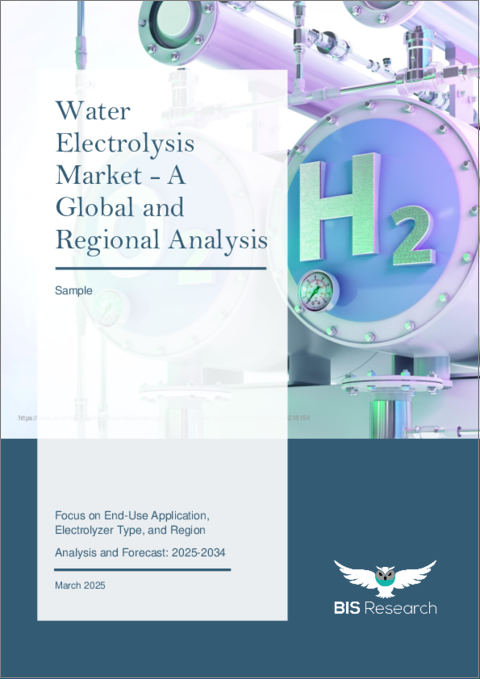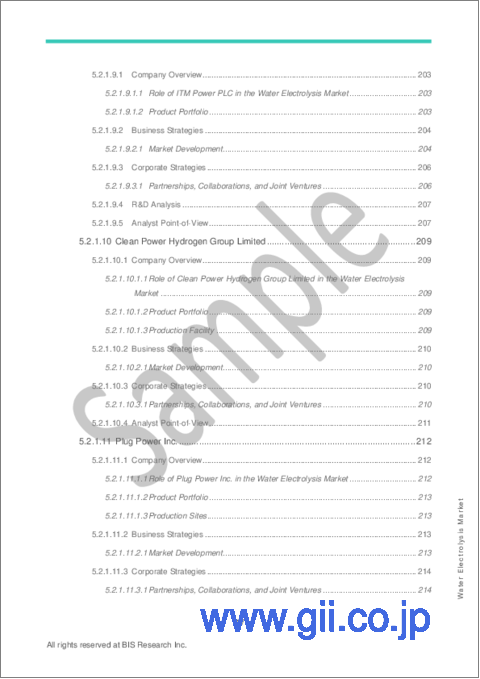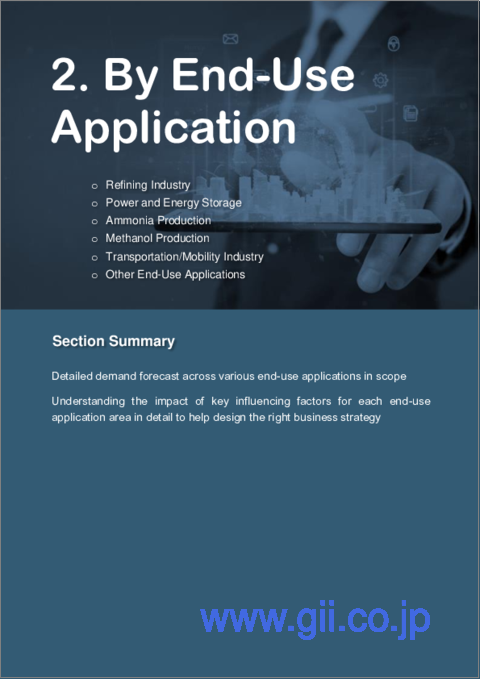|
|
市場調査レポート
商品コード
1681009
水電解市場- 世界および地域別分析:最終用途別、電解槽タイプ別、地域別 - 分析と予測(2025年~2034年)Water Electrolysis Market - A Global and Regional Analysis: Focus on End-Use Application, Electrolyzer Type, and Region - Analysis and Forecast, 2025-2034 |
||||||
カスタマイズ可能
|
|||||||
| 水電解市場- 世界および地域別分析:最終用途別、電解槽タイプ別、地域別 - 分析と予測(2025年~2034年) |
|
出版日: 2025年03月18日
発行: BIS Research
ページ情報: 英文 120 Pages
納期: 1~5営業日
|
全表示
- 概要
- 目次
電解槽は、電気を利用して水を水素と酸素に分解するシステムです。
このプロセスは電気分解として知られ、主に水素の生成に使用され、水素は圧縮ガスまたは液化ガスとして貯蔵されます。電気分解の過程で生成された酸素は、大気中に放出されるか、他の目的に使用するために貯蔵されます。
国際エネルギー機関(IEA)は、2040年までにエネルギー需要が25%から30%増加すると予測しており、企業や政府は持続可能で低炭素排出のエネルギー源を見つけようとしています。水素は未来の燃料と呼ばれており、IEAは、水の電気分解から水素を製造することで、年間8億3,000万トンのCO2が大気中に流入するのを防ぐことができると予測しています。さらに、水素燃料電池車、グリーンアンモニア、グリーンメタノール、その他の用途への需要の高まりが、水電解市場の成長を促進しています。
水電解は古い技術で、1789年にオランダの商人Jan Rudolph DeimanとAdriaan Paets van Troostwijkによって初めて導入されました。彼は金電極と静電気発生装置を使い、水中に静電気放電を発生させました。それから約100年後の1888年、ロシア人技師Dmitry Lachinovが、水素と酸素を生成する初の工業用水電解槽を開発しました。1960年代半ばには、General Electricがジェミニ宇宙計画のためにプロトン交換膜プロセスを導入し、後に水素製造に採用されました。現在、市場で入手可能な電解槽は4種類あり、アルカリと固体高分子電解質膜(PEM)はすでに商業化されており、陰イオン交換膜(AEM)と固体酸化物は商業化の初期段階にあります。
水電解市場の成長は、水素およびアンモニア市場と密接に結びついています。水電解はクリーンな水素製造法のひとつであり、排出物がなく、水素製造に使用される原料が水であるため、持続可能性が高いです。グリーン水素とグリーンアンモニアに対する需要の高まりは、水電解市場成長の主な促進要因のひとつです。
当レポートでは、世界の水電解市場について調査し、市場の概要とともに、最終用途別、電解槽タイプ別、地域別の動向、および市場に参入する企業のプロファイルなどを提供しています。
目次
エグゼクティブサマリー
第1章 市場:業界の展望
- 動向:現在および将来の影響評価
- ステークホルダー分析
- 市場力学の概要
- 規制状況
- 特許分析
- スタートアップの情勢
- サプライチェーン分析
- バリューチェーン分析
- 世界価格分析
- 業界の魅力
- 今後の道
- グリーン水素市場のスナップショット
- グリーンアンモニア市場のスナップショット
第2章 水電解市場(用途別)
- 用途のセグメンテーション
- 用途のサマリー
- 水電解市場(最終用途)
第3章 水電解市場(製品別)
- 製品のセグメンテーション
- 製品のサマリー
- 水電解市場(電解装置タイプ別)
第4章 水電解市場(地域別)
- 水電解市場(地域別)
- 北米
- 欧州
- アジア太平洋
- その他の地域
第5章 市場-競合ベンチマーキングと企業プロファイル
- 今後の見通し
- 地理的評価
- 企業プロファイル
- Asahi Kasei Corporation
- Nel ASA
- thyssenkrupp AG
- Cummins Inc.
- Toshiba Energy Systems & Solutions Corporation
- Teledyne Energy Systems Inc.
- Suzhou Green Hydrogen Energy Co., Ltd.
- Suzhou Jingli Hydrogen Production Equipment Co., Ltd.
- ITM Power PLC
- Clean Power Hydrogen Group Limited
- Plug Power Inc.
- Hitachi Zosen Corporation
- John Cockerill
- Siemens Energy AG
- McPhy Energy S.A.
- Enapter AG
- Elogen
- h2e Power Systems Pvt. Ltd.
- Ohmium
- Hystar
第6章 調査手法
Global Water Electrolysis Market Industry Overview
An electrolyzer is a system that breaks water into hydrogen and oxygen with the help of electricity. This process is known as electrolysis and it is mainly used to produce hydrogen, which is then stored as a compressed or liquefied gas. Oxygen produced during the electrolysis process is either released into the atmosphere or is stored to use for other purposes.
International Energy Agency (IEA) has projected that the energy demand will grow between 25% to 30% by 2040 with companies and governments trying to find sustainable and low-carbon emission energy sources. Hydrogen is being called the fuel of the future and IEA has projected that hydrogen production from water electrolysis can prevent the 830 million tons of CO2 annually from entering the atmosphere. Moreover, the growing demand for hydrogen fuel cell vehicles, green ammonia, green methanol, and other applications is driving the growth of the water electrolysis market.
Water Electrolysis Market Lifecycle Stage
Water electrolysis is old technology and was first introduced in 1789 by the Dutch merchants Jan Rudolph Deiman and Adriaan Paets van Troostwijk, who used gold electrodes and an electrostatic generator to produce an electrostatic discharge in water. Almost 100 years later in 1888, Russian engineer Dmitry Lachinov developed the first industrial water electrolyzer for producing hydrogen and oxygen. In the mid-1960s, General Electric introduced the proton exchange membrane process for the Gemini Space Program, and it was later adopted for hydrogen production. Currently, there are four types of electrolyzers available in the market alkaline and polymer electrolyte membrane (PEM) already commercialized and anion exchange membrane (AEM) and solid oxide at an early stage of commercialization.
Industrial Impact
The growth of the water electrolysis market is closely tied to the hydrogen and ammonia market. Water electrolysis is one of the clean methods for the production of hydrogen and is highly sustainable as there are no emissions and the feedstock used for hydrogen production is water. The growing demand for green hydrogen and green ammonia are among the major drivers of the growth of the water electrolysis market.
Market Segmentation:
Segmentation 1: by End-Use Application
- Transportation/Mobility Industry
- Refining Industry
- Power and Energy Storage
- Ammonia Production
- Methanol Production
- Other End-Use Applications
Segmentation 2: by Electrolyzer Type
- Alkaline Electrolyzer
- Proton Exchange Membrane (PEM) Electrolyzer
- Solid Oxide Electrolyzer Cell (SOEC)
- Anion Exchange Membrane (AEM) Electrolyzers
The water electrolysis market is dominated by alkaline electrolyzers owing to the large-scale application of alkaline water electrolysis. Moreover, the first commercialized water electrolysis systems were based on alkaline water electrolysis. The low cost and technological maturity of alkaline water electrolyzers further support the dominant share of these electrolyzers in the market.
Segmentation 3: by Region
- North America - U.S., Canada, and Mexico
- Europe - Germany, France, Netherlands, U.K., Spain, and Rest-of-Europe
- Asia-Pacific - China, Japan, India, South Korea, Australia, and Rest-of-Asia-Pacific and Japan
- Rest-of-the-World - South America, Middle East and Africa
Asia-Pacific and Japan are anticipated to gain traction in terms of the water electrolysis market owing to the presence of a large number of players, growing demand for green hydrogen, investment from the government, and the large fleet of fuel-cell vehicles in the region. Moreover, the rising demand for green ammonia and the development of hydrogen infrastructure in the region are expected to further support the dominant share of the region in the market.
Recent Developments in the Water Electrolysis Market
- In June 2022, Bosch announced that it will invest $1.3 billion by 2025 in hydrogen. The company has already invested significantly in fuel cell technology and the company is now planning to leverage its expertise in fuel cell technology to develop electrolyzers with an investment of $600 million by 2030.
- In June 2022, De Nora Water Technologies and Saline Water Conversion Corporation (SWCC) announced that they have expanded their partnership and had signed a memorandum of understanding (MOU) for brine mining and water electrolysis research.
- In June 2022, Hyundai Engineering & Construction (Hyundai E&C) announced that the Ministry of Trade, Industry, and Energy has chosen the company for building a water electrolysis-based hydrogen production base project. The company will be responsible for building a base for producing, storing, and transporting more than one ton of hydrogen per day.
- In May 2022, Frontier Energy Ltd. announced that it has chosen alkaline water electrolysis (AWE) as the preferred electrolysis technology for the production of green hydrogen at the Bristol Springs Solar (BSS) Project south of Perth in Western Australia. The company chose AWE over other water electrolysis technologies due to its low cost and technological robustness.
- In April 2022, ThyssenKrupp nucera announced that Air Products has selected the company for the supply of its alkaline water electrolysis technology to produce green liquid hydrogen in Casa Grande, Arizona in a 10 metric ton per day facility.
Demand - Drivers and Limitations
Following are the demand drivers for the water electrolysis market:
- Growing demand for green hydrogen for green ammonia and green methanol
- Rising investment and favorable policies from the government
- Hydrogen demand for energy storage
The market is expected to face some limitations too due to the following challenges:
- High capital investment requirement for water electrolysis
- Highly volatile prices of precious metals like iridium, ruthenium, and platinum used as a catalyst in water electrolysis
How Can This Report Add Value to an Organization?
Product/Innovation Strategy: The product segment helps the reader understand the different types of electrolyzers available for deployment and their potential globally. Moreover, the study provides the reader with a detailed understanding of the water electrolysis market by end-use application (transportation, refining, power, and energy generation, ammonia production, green hydrogen production, and other end-use applications) and by electrolyzer type (alkaline electrolyzer, proton exchange membrane electrolyzer (PEM), anion exchange membrane electrolyzer (AEM), solid oxide electrolyzer).
Growth/Marketing Strategy: The water electrolysis market has seen major development by key players operating in the market, such as business expansion, partnership, collaboration, and joint venture. The favored strategy for the companies has been partnerships and joint ventures, to strengthen their position in the water electrolysis market. For instance, in November 2021, Plug Power Inc. announced a joint venture with SK E&S Co., ltd. to open a Gigafactory in South Korea and another joint venture with Fortescue Futureindustries Pty ltd. for a Gigafactory in Australia.
Competitive Strategy: Key players in the water electrolysis market analyzed and profiled in the study involve major water electrolyzer manufacturers. Moreover, a detailed competitive benchmarking of the players operating in the water electrolysis market has been done to help the reader understand how players stack against each other, presenting a clear market landscape. Additionally, comprehensive competitive strategies such as partnerships, agreements, and collaborations will aid the reader in understanding the untapped revenue pockets in the market.
Key Players in Water Electrolysis Market and Competition Synopsis
The companies that are profiled have been selected based on inputs gathered from primary experts and analyzing company coverage, product portfolio, and market penetration.
Some prominent names established in this market are:
Company Type 1: Electrolyzer Suppliers
- Nel ASA
- Cummins Inc.
- Plug Power Inc.
- ITM Power plc
- ThyssenKrupp
- Asahi Kasei
- Others
Companies that are not a part of the above-mentioned pool have been well represented across different sections of the report (wherever applicable).
Table of Contents
Executive Summary
Scope and Definition
Market/Product Definition
Key Questions Answered
Analysis and Forecast Note
1. Markets: Industry Outlook
- 1.1 Trends: Current and Future Impact Assessment
- 1.2 Stakeholder Analysis
- 1.2.1 Use Case
- 1.2.2 End User and Buying Criteria
- 1.3 Market Dynamics Overview
- 1.3.1 Market Drivers
- 1.3.2 Market Restraints
- 1.3.3 Market Opportunities
- 1.4 Regulatory Landscape
- 1.5 Patent Analysis
- 1.6 Start-Up Landscape
- 1.7 Supply Chain Analysis
- 1.8 Value Chain Analysis
- 1.9 Global Pricing Analysis
- 1.10 Industry Attractiveness
- 1.11 The Road Ahead
- 1.12 Snapshot of the Green Hydrogen Market
- 1.13 Snapshot of the Green Ammonia Market
2. Water Electrolysis Market (by Application)
- 2.1 Application Segmentation
- 2.2 Application Summary
- 2.3 Water Electrolysis Market (by End-Use Application)
- 2.3.1 Refining Industry
- 2.3.2 Power and Energy Storage
- 2.3.3 Ammonia Production
- 2.3.4 Methanol Production
- 2.3.5 Transportation/Mobility Industry
- 2.3.6 Other End-Use Applications
3. Water Electrolysis Market (by Product)
- 3.1 Product Segmentation
- 3.2 Product Summary
- 3.3 Water Electrolysis Market (by Electrolyzer Type)
- 3.3.1 Alkaline Electrolyzer
- 3.3.2 Proton Exchange Membrane (PEM) Electrolyzer
- 3.3.3 Solid Oxide Electrolyzer Cell (SOEC)
- 3.3.4 Anion Exchange Membrane (AEM) Electrolyzers
4. Water Electrolysis Market (by Region)
- 4.1 Water Electrolysis Market (by Region)
- 4.2 North America
- 4.2.1 Regional Overview
- 4.2.2 Driving Factors for Market Growth
- 4.2.3 Factors Challenging the Market
- 4.2.4 Key Companies
- 4.2.5 Application
- 4.2.6 Product
- 4.2.7 U.S.
- 4.2.7.1 Market by Application
- 4.2.7.2 Market by Product
- 4.2.8 Canada
- 4.2.8.1 Market by Application
- 4.2.8.2 Market by Product
- 4.2.9 Mexico
- 4.2.9.1 Market by Application
- 4.2.9.2 Market by Product
- 4.3 Europe
- 4.3.1 Regional Overview
- 4.3.2 Driving Factors for Market Growth
- 4.3.3 Factors Challenging the Market
- 4.3.4 Key Companies
- 4.3.5 Application
- 4.3.6 Product
- 4.3.7 Germany
- 4.3.7.1 Market by Application
- 4.3.7.2 Market by Product
- 4.3.8 France
- 4.3.8.1 Market by Application
- 4.3.8.2 Market by Product
- 4.3.9 The Netherlands
- 4.3.9.1 Market by Application
- 4.3.9.2 Market by Product
- 4.3.10 Spain
- 4.3.10.1 Market by Application
- 4.3.10.2 Market by Product
- 4.3.11 U.K.
- 4.3.11.1 Market by Application
- 4.3.11.2 Market by Product
- 4.3.12 Rest-of-Europe
- 4.3.12.1 Market by Application
- 4.3.12.2 Market by Product
- 4.4 Asia-Pacific
- 4.4.1 Regional Overview
- 4.4.2 Driving Factors for Market Growth
- 4.4.3 Factors Challenging the Market
- 4.4.4 Key Companies
- 4.4.5 Application
- 4.4.6 Product
- 4.4.7 China
- 4.4.7.1 Market by Application
- 4.4.7.2 Market by Product
- 4.4.8 Japan
- 4.4.8.1 Market by Application
- 4.4.8.2 Market by Product
- 4.4.9 India
- 4.4.9.1 Market by Application
- 4.4.9.2 Market by Product
- 4.4.10 South Korea
- 4.4.10.1 Market by Application
- 4.4.10.2 Market by Product
- 4.4.11 Australia
- 4.4.11.1 Market by Application
- 4.4.11.2 Market by Product
- 4.4.12 Rest-of-Asia-Pacific
- 4.4.12.1 Market by Application
- 4.4.12.2 Market by Product
- 4.5 Rest-of-the-World
- 4.5.1 Regional Overview
- 4.5.2 Driving Factors for Market Growth
- 4.5.3 Factors Challenging the Market
- 4.5.4 Key Companies
- 4.5.5 Application
- 4.5.6 Product
- 4.5.7 South America
- 4.5.7.1 Market by Application
- 4.5.7.2 Market by Product
- 4.5.8 Middle East and Africa
- 4.5.8.1 Market by Application
- 4.5.8.2 Market by Product
5. Markets - Competitive Benchmarking & Company Profiles
- 5.1 Next Frontiers
- 5.2 Geographic Assessment
- 5.3 Company Profiles
- 5.3.1 Asahi Kasei Corporation
- 5.3.1.1 Overview
- 5.3.1.2 Top Products/Product Portfolio
- 5.3.1.3 Top Competitors
- 5.3.1.4 Target Customers
- 5.3.1.5 Key Personnel
- 5.3.1.6 Analyst View
- 5.3.1.7 Market Share
- 5.3.2 Nel ASA
- 5.3.2.1 Overview
- 5.3.2.2 Top Products/Product Portfolio
- 5.3.2.3 Top Competitors
- 5.3.2.4 Target Customers
- 5.3.2.5 Key Personnel
- 5.3.2.6 Analyst View
- 5.3.2.7 Market Share
- 5.3.3 thyssenkrupp AG
- 5.3.3.1 Overview
- 5.3.3.2 Top Products/Product Portfolio
- 5.3.3.3 Top Competitors
- 5.3.3.4 Target Customers
- 5.3.3.5 Key Personnel
- 5.3.3.6 Analyst View
- 5.3.3.7 Market Share
- 5.3.4 Cummins Inc.
- 5.3.4.1 Overview
- 5.3.4.2 Top Products/Product Portfolio
- 5.3.4.3 Top Competitors
- 5.3.4.4 Target Customers
- 5.3.4.5 Key Personnel
- 5.3.4.6 Analyst View
- 5.3.4.7 Market Share
- 5.3.5 Toshiba Energy Systems & Solutions Corporation
- 5.3.5.1 Overview
- 5.3.5.2 Top Products/Product Portfolio
- 5.3.5.3 Top Competitors
- 5.3.5.4 Target Customers
- 5.3.5.5 Key Personnel
- 5.3.5.6 Analyst View
- 5.3.5.7 Market Share
- 5.3.6 Teledyne Energy Systems Inc.
- 5.3.6.1 Overview
- 5.3.6.2 Top Products/Product Portfolio
- 5.3.6.3 Top Competitors
- 5.3.6.4 Target Customers
- 5.3.6.5 Key Personnel
- 5.3.6.6 Analyst View
- 5.3.6.7 Market Share
- 5.3.7 Suzhou Green Hydrogen Energy Co., Ltd.
- 5.3.7.1 Overview
- 5.3.7.2 Top Products/Product Portfolio
- 5.3.7.3 Top Competitors
- 5.3.7.4 Target Customers
- 5.3.7.5 Key Personnel
- 5.3.7.6 Analyst View
- 5.3.7.7 Market Share
- 5.3.8 Suzhou Jingli Hydrogen Production Equipment Co., Ltd.
- 5.3.8.1 Overview
- 5.3.8.2 Top Products/Product Portfolio
- 5.3.8.3 Top Competitors
- 5.3.8.4 Target Customers
- 5.3.8.5 Key Personnel
- 5.3.8.6 Analyst View
- 5.3.8.7 Market Share
- 5.3.9 ITM Power PLC
- 5.3.9.1 Overview
- 5.3.9.2 Top Products/Product Portfolio
- 5.3.9.3 Top Competitors
- 5.3.9.4 Target Customers
- 5.3.9.5 Key Personnel
- 5.3.9.6 Analyst View
- 5.3.9.7 Market Share
- 5.3.10 Clean Power Hydrogen Group Limited
- 5.3.10.1 Overview
- 5.3.10.2 Top Products/Product Portfolio
- 5.3.10.3 Top Competitors
- 5.3.10.4 Target Customers
- 5.3.10.5 Key Personnel
- 5.3.10.6 Analyst View
- 5.3.10.7 Market Share
- 5.3.11 Plug Power Inc.
- 5.3.11.1 Overview
- 5.3.11.2 Top Products/Product Portfolio
- 5.3.11.3 Top Competitors
- 5.3.11.4 Target Customers
- 5.3.11.5 Key Personnel
- 5.3.11.6 Analyst View
- 5.3.11.7 Market Share
- 5.3.12 Hitachi Zosen Corporation
- 5.3.12.1 Overview
- 5.3.12.2 Top Products/Product Portfolio
- 5.3.12.3 Top Competitors
- 5.3.12.4 Target Customers
- 5.3.12.5 Key Personnel
- 5.3.12.6 Analyst View
- 5.3.12.7 Market Share
- 5.3.13 John Cockerill
- 5.3.13.1 Overview
- 5.3.13.2 Top Products/Product Portfolio
- 5.3.13.3 Top Competitors
- 5.3.13.4 Target Customers
- 5.3.13.5 Key Personnel
- 5.3.13.6 Analyst View
- 5.3.13.7 Market Share
- 5.3.14 Siemens Energy AG
- 5.3.14.1 Overview
- 5.3.14.2 Top Products/Product Portfolio
- 5.3.14.3 Top Competitors
- 5.3.14.4 Target Customers
- 5.3.14.5 Key Personnel
- 5.3.14.6 Analyst View
- 5.3.14.7 Market Share
- 5.3.15 McPhy Energy S.A.
- 5.3.15.1 Overview
- 5.3.15.2 Top Products/Product Portfolio
- 5.3.15.3 Top Competitors
- 5.3.15.4 Target Customers
- 5.3.15.5 Key Personnel
- 5.3.15.6 Analyst View
- 5.3.15.7 Market Share
- 5.3.16 Enapter AG
- 5.3.16.1 Overview
- 5.3.16.2 Top Products/Product Portfolio
- 5.3.16.3 Top Competitors
- 5.3.16.4 Target Customers
- 5.3.16.5 Key Personnel
- 5.3.16.6 Analyst View
- 5.3.16.7 Market Share
- 5.3.17 Elogen
- 5.3.17.1 Overview
- 5.3.17.2 Top Products/Product Portfolio
- 5.3.17.3 Top Competitors
- 5.3.17.4 Target Customers
- 5.3.17.5 Key Personnel
- 5.3.17.6 Analyst View
- 5.3.17.7 Market Share
- 5.3.18 h2e Power Systems Pvt. Ltd.
- 5.3.18.1 Overview
- 5.3.18.2 Top Products/Product Portfolio
- 5.3.18.3 Top Competitors
- 5.3.18.4 Target Customers
- 5.3.18.5 Key Personnel
- 5.3.18.6 Analyst View
- 5.3.18.7 Market Share
- 5.3.19 Ohmium
- 5.3.19.1 Overview
- 5.3.19.2 Top Products/Product Portfolio
- 5.3.19.3 Top Competitors
- 5.3.19.4 Target Customers
- 5.3.19.5 Key Personnel
- 5.3.19.6 Analyst View
- 5.3.19.7 Market Share
- 5.3.20 Hystar
- 5.3.20.1 Overview
- 5.3.20.2 Top Products/Product Portfolio
- 5.3.20.3 Top Competitors
- 5.3.20.4 Target Customers
- 5.3.20.5 Key Personnel
- 5.3.20.6 Analyst View
- 5.3.20.7 Market Share
- 5.3.1 Asahi Kasei Corporation





